
SongBook Chordpro for iOS runs on all 64bit iPhones and iPads with iOS 14 or higher. It is fully compatible with iOS 26 and the latest devices.
When you upgrade to a new version, all songs and settings will be preserved. You'll find the complete version history at the bottom of this document.
See demo on YouTube. Tutoriel français by Alain Lachapelle. Function map by Peter Reath. Czech blog by Karel Jačko.
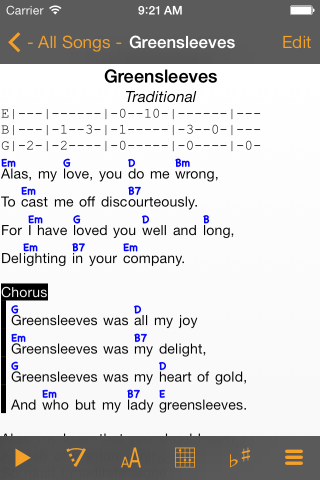
Where To Find Songs For SongBook
SongBook uses the chordpro format, a plain text file format where chords are written in square brackets within the lyrics. It can also work with tab files. Unfortunately, we cannot provide songs on this site due to copyright restrictions. However, the Internet has huge archives of songs in chordpro or tab format: simply type the song name and chords or tabs into your favorite search engine. Or use the built-in Internet search.
You can also easily create your own chordpro songs. Write the lyrics as usual and insert the chord names in square brackets at the appropriate positions as in the following example:
[Em]Alas, my [G]love, you [D]do me [Bm]wrong,
SongBook will render this as:
| Em | G | D | Bm |
| Alas, my | love, you | do me | wrong, |
A detailed explanation of the chordpro format as supported by SongBook is available here.
Note: Our desktop applications SongBook Windows and SongBook Mac make it easier to edit or convert chordpro and tab songs on a bigger screen.
How To Get Songs Into SongBook
The SongBook documents folder is accessible in iTunes or Finder. Select SongBook on the Files tab and drag/drop songs to/from Explorer/Finder.
The following file extensions are understood by SongBook
*.pro, *.chordpro, *.chopro, *.txt (native chordpro files)
*.tab, *.crd (tab files, chords on separate lines)
*.lst (playlist files)
*.pdf (PDF files
*.chords.txt (user defined chords)
SongBook can also open files with supported extensions, from e.g. mail attachments, Dropbox or other file sharing apps.
You can import song files from iCloud Drive, Dropbox or others with the Files-App. Tap on - All Songs - or a category, then use the + button at the bottom to select From Files.
Note: SongBook does not work with DOC files, because these cannot be easily reformatted, transposed, searched etc. You need to save your songs in plain text format with one of the supported file extensions (see above) to be able to use them with SongBook.
Cloud SyncYou can synchronize your song collections with various cloud storages: Dropbox, Microsoft OneDrive (consumer only, OneDrive Business not supported) , or Nextcloud. Simply link with with your cloud account in Settings, and copy your song files to the /SongBook directory and its subdirectories in the root folder. On iOS 14 or higher you can also sync with a folder in the Files app (if the storage provider supports it), e.g. an iCloud Drive folder or a folder in On My iPhone/iPad, or a USB drive. Select Link Folder in Files, then navigate to the folder and tap Open in the top right.
Use the refresh button ![]() on the Songs tab to start the synchronization or select Automatic in Settings to sync whenever you go to the Songs tab. Select a song category or go to a different tab to stop the sync any time. We do not use your cloud account data in any way other than to sync your songs. See also this privacy policy for our apps.
on the Songs tab to start the synchronization or select Automatic in Settings to sync whenever you go to the Songs tab. Select a song category or go to a different tab to stop the sync any time. We do not use your cloud account data in any way other than to sync your songs. See also this privacy policy for our apps.
If your files do not show up in SongBook, check whether they have one of the supported file extensions (see above).
Note: Synchronization is two-way and (except for the first sync) includes all deletions and modifications since the last sync. It will also sync playlists and custom chords. For technical reasons, subdirectories of the SongBook directory (categories) can only be renamed/removed on the device. To overwrite all songs on the device, unlink SongBook from Dropbox/OneDrive in Settings, then delete all songs/categories, then link the app again.
To synchronize SongBook Windows or SongBook Mac with SongBook Android, just select the Dropbox/OneDrive/iCloud Drive SongBook folder on the PC/Mac as your song folder (with the "..." button next to the category dropdown). Then link and sync SongBook iOS as described above. See this video for details.
Coming soon:SongBook Cloud sync and share.
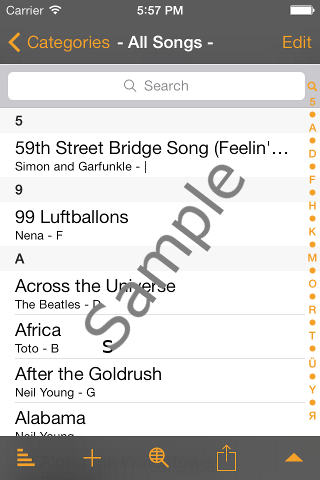
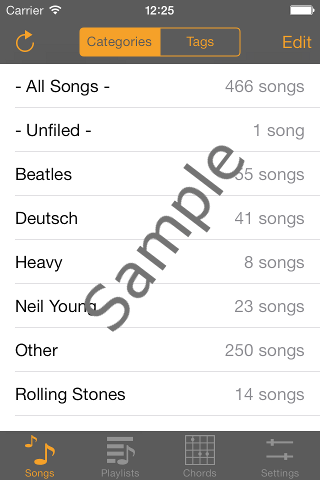
Song List
Songs are structured in categories. Categories are similar to folders on your computer. You can group songs in categories to help you both organize and search through your song titles. But, just like folders on your computer, deleting a category will delete all songs in it. Songs can also be organized in playlists and filtered by tags.
Use Edit on the Categories list to add, rename or remove a whole category. Removing a category will also remove all songs in that category. From the Edit Categories view, you can add (move) multiple songs to a category by tapping on the + button. Unchecking a song will move it back to - Unfiled -. To put a single song in a different category, open the song, then select Category from the action menu in the lower right.
The song list displays title/subtitle and key of all songs in the selected category. SongBook determines the key by looking at the first chord in the song, or the value of the {key: ...} directive. You can search for a song by title, subtitle, or full text.
To create new songs, select a category, then tap on the + button on the lower toolbar.
Use the sort toolbar button to sort the song list by title, subtitle, key, or last modification date.
Use Edit on the song list (or swipe-to-delete) to delete individual songs.
The globe search button in the middle of the bottom song list toolbar will open a simple Internet search for songs in chordpro format. Songs imported via the search will be added to the currently selected category.
The button on the lower right will give you quick access to the tab to switch to playlists, chords or settings.
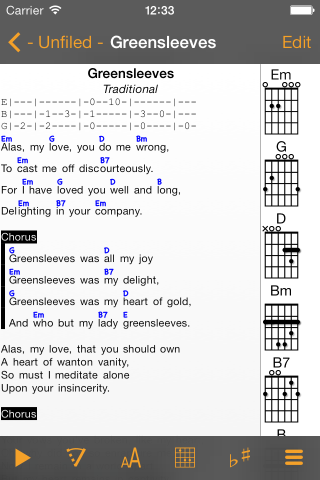 Song View
Song View
The song view displays the current song with lyrics and chords. Tap on a chord to look up the chord definitions. Use the chord toolbar button to toggle display of the currently used chords at the bottom (or to the right) of the song. The list will start with the first chord of the currently visible part of the song.
Chord, lyrics, comments and tab font and text/background color can be changed by selecting Settings from the action button in the lower right.
Tap with two fingers on the lower/upper third of the song to scroll down/up one page.
Swipe right/left or tap with two fingers in the center part of the song on the left/right side to move to the previous/next song in the currently selected category/playlist.
![]()
The toolbar at the bottom gives you access to several functions which in turn will show their own toolbars or menus. On the iPhone in portrait mode some functions are only accessible via the menu button in the lower right due to limited space. Tap anywhere on the screen to go back to the standard toolbar.
Auto-Scrolling
![]()
The play button will start auto-scrolling the song. You can adjust the total playing time mm:ss of the song (including the last page) with the slider or the +/- buttons. Tap Save to save the playing time in the song (as a {time: } directive). To temporarily pause the current scrolling, tap with two fingers anywhere on the screen. Repeating this multiple times will add to the delay. A three-finger tap will start/stop auto-scrolling without the need to open the auto-scroll toolbar. Note: this will only work if you have not assigned this gesture to some other function in the global iOS settings.
You can optionally insert {pause: x} directives somewhere in a song, where x denotes a pause in seconds (e.g. {pause: 20} to pause for 20 seconds). When the line with this pause statement reaches the top of the screen, auto-scrolling will pause for this amount of time. You can also put that directive at the top of the song to delay the auto-scroll start.
![]()
SongBook features a built-in metronome. You can configure whether you want an audible tick or a flash of the upper toolbar (or upper part of the screen) or both in Settings. Use the Save button to save the current metronome speed (in ticks/beats per minute, as {metronome: } directive) in the song. Use the Play button at the right to switch to auto-scroll (and vice versa).
If the song contains a {time: 3/4} directive or similar, the metronome will sound with an up-time beat, and the number will also be used for count-in.
SongBook also supports sending MIDI commands with each metronome tick or flash.
![]()
You can change the font sizes for the current song with the familiar "pinch" gesture, or with the font size icon on the lower toolbar. The pinch gesture changes the zoom level only for the currently displayed song. The zoom buttons change the zoom level permanently for all songs. Use the Save button to save the current zoom level with the song (as a {zoom-iphone/ipad: } directive) so that this particular song will always display in the selected size.
Unlike zooming of pictures, zooming of songs in SongBook will trigger a re-layout of the song, so you will never have to scroll horizontally.
The Auto-Zoom option will zoom the song so that everything fits on one page without scrolling.
Use the chord toolbar button to switch on/off the chord band on the lower/right border (configured in Settings). This chord list shows the easiest variant (or the {define...} variant) for each chord currently visible on the screen. If you don't like the inverted display, switch it off in Settings. If you select the piano instrument in Settings, you will see the notes of the chord (treble). Tap on the chord to see the full chord view with all definitions.
Pedals
You can use AirTurn or similar bluetooth or USB pedals or MIDI pedals to scroll page-wise up/down and switch to the next/previous song in the current category or playlist. The latter can be switched off in Settings. There you can also configure to start auto-scrolling with a pedal down. The page percentage to scroll can also be configured.
The pedals should be set to send Page Up/Down or Arrow Up/Down keys. In addition, the following keys are supported:
- Cmd-A: Start/Stop Auto-Scroll
- Cmd-M: Play linked music
- Cmd-F: Full screen on/off
- Cmd-O: Start/Stop Metronome
- Cmd-C: Show/Hide chords band
- Cmd-E: Edit
- Arrow Left: Previous Song
- Arrow Right: Next Song
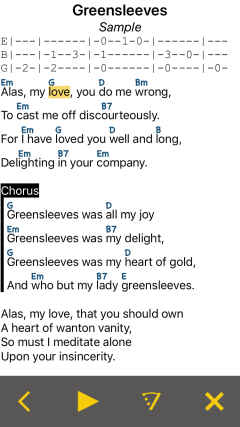 Concert Mode
Concert Mode
You can select a special concert mode for simplified usage in live situations in the menu. When this mode is active, the song will be displayed full-screen, with a few bigger buttons at the bottom to go back to song list, start/stop auto-scroll, start/stop music, start/stop metronome and exit. In concert mode, you cannot tap on a chord, instead you can use a single tap in the upper/lower part of the screen to scroll up/down, and swipe left/right for the next/previous song.
Transpose
![]()
You can transpose the song into a different key by tapping on the b# toolbar button. Tap on the b/# buttons to change the tuning in half-tone steps or choose the key to transpose to directly from the popup. To determine the current key, SongBook will look at the {key: ...} directive or (if not found) use the first chord of the song. You can define the key from the menu at the right.
Use the "All b" and "All #" buttons to convert all sharp chords to their flat equivalent or vice versa. Tap on the Save button to permanently save the changed chords in the song, use the reset button ↺ to reset to the original key. If you just tap outside the transpose toolbar, the current transposition will be active until you switch to another song.
You can use Set Capo to define a fret for a capo. This works just like a transpose down the same number of steps, but will show a Capo: ... indicator at the beginning of the song.
The menu at the right-hand side lets you convert song chords into the Nashville Numbering System which will convert all chord names into number 1,2,3... This only works if a key is set in the song (with Set Key from the menu). If a song is already in Nashville Number format, you can convert it back into regular chords (again based on the defined key). Use the reset button ↺ to undo the conversion.
More Song Functions
The menu button on the right of the main toolbar offers various additional song actions. It lets you switch off display of chords or lyrics, mail the song as an attachment (as chordpro file, formatted PDF or plain text), or change the category or assign the song to a playlist. If you have an AirPrint-capable printer, you can print the current song.

If you want to play along with a backing track, you can link a SongBook song to an Apple Music file with the menu in the lower right. SongBook will automatically link matching songs based on the song title. Once a SongBook song is linked to a music file, the metronome button is replaced with a notes button to show a mini player toolbar. Start/pause the music with the note/pause button in the lower left. You can rewind/fast forward the music, or start the auto-scroll with the button at the lower right. Unlink a connected music file from the menu.
Alternatively, you can select an MP3 file from the Files app. SongBook will copy the MP3 into song folder and insert a statement {musicpath: file.mp3} in the song. This works across all devices and platforms. Note: for PDFs, there is an automatic link to a music file with the same name in the same folder, e.g. Song.pdf -> Song.mp3
You can insert multiple {musicpath: ...} statements to switch between different backing tracks, e.g. for rehearsals. You can also adjust the playback speed of the music, e.g. to practice with a lower speed. If you use auto-scroll, the scroll speed and pauses will be automatically adjusted.
Play together
![]()
You can link up to seven iOS or Mac OS X devices running SongBook together, so they will always show the same song and scroll to the same line. Enable Bluetooth or WiFi on all devices, then select Settings - Play together to start the search for other devices. If a song is not found on one of the connected devices or has a different content it can be copied automatically. When you transpose a song, the transpose step will also be sent to the other devices. The connection is peer-to-peer: every device can control all other devices. When a device switches off or shows the lock screen, the connection will be dropped. SongBook will automatically try to re-connect once it is back in the foreground.
Note: PDFs are currently not supported in Play Together mode.
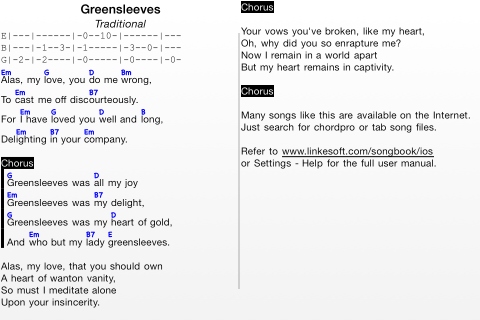 Full Screen and VGA Mode
Full Screen and VGA Mode
To make maximum use of screen real-estate, SongBook can display a song in full screen mode where the whole display is used to display the song. To switch to/from full screen mode, just tap anywhere on the song view (not on a chord).
SongBook will automatically switch to multi-column mode if the song is narrow enough and would fit without scrolling on the screen.
When you connect a projector or external display using Apple's VGA or HDMI adapter to your iOS device, SongBook will show the current song (or chord view) with full resolution on this display. Note that the screen ratio of the external display may differ from your iPhone/iPad, so the song view on the device is resized to match the display, and may consequently show black stripes. When you scroll/zoom on the device, the song on the display will scroll/zoom accordingly. Note: on newer iPad devices with the HDMI adapter, the device screen will be 1:1 mirrored to the external device using AirPlay. With an external display connected, you can change the external display to only show lyrics via the menu. This can be useful if your audience wants to sing the song you're playing.
If you have a Google Chromecast device in your network and select it from the Chromecast button ![]() , SongBook will display the current song in auto-zoom mode on the Chromecast TV/projector.
, SongBook will display the current song in auto-zoom mode on the Chromecast TV/projector.
You can optionally rotate the output on external displays, e.g. if you use a monitor rotated 90 degrees.
Note: SongBook will automatically increase the auto power-off (idle) timeout up to 15min while a song is displayed.
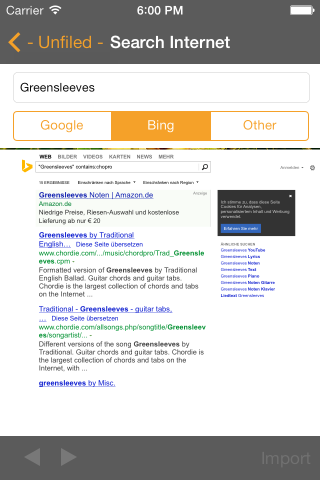 Internet Search
Internet Search
SongBook has a simple Internet search for chordpro files built-in. You can use one of the two main search providers, or type a URL of your own. If the displayed page contains a pre-formatted song, the Import button in the lower right will become active and open the song editor. You can then save the song in the song list or cancel the edit and get back to the search view.
Note: By it's very nature, Internet search can be hit-or-miss, results may vary. You are responsible for obeying the respective copyrights of the material found on the Internet.
MIDI-Support
SongBook supports MIDI on all iOS devices. When MIDI is activated in menu Settings, SongBook will connect to all input and output sources on the MIDI bus.
You can select a song with a MIDI command by inserting a directive {midi-index: <command>, <command>,...} in the song.
You can also send certain MIDI commands when opening a song by inserting {midi: <command>,<command>,...} in the song. You can use multiple {midi: ...}
commands in a song for better structuring, they will all be sent together when you open the song.
You can also use a MIDI pedal to scroll up/down in a song, by entering the respective command in Settings.
The general MIDI command syntax is <id><MSB>.<LSB>:<subvalue>@<channel> (see table below). Numbers are decimal, except when sending (hex) bytes directly. In most cases the easiest way to find out what to send is to just select the MIDI command from the list of last received commands (via menu in song editor, or for up/down pedal in Settings).
| Command | Explanation | Example |
| N | Note (On/Off) | N60 |
| PC | Program Change | PC6 |
| CC | Control Change/Bank Select | CC100.10 |
| SS | Song Select | SS99 |
| START | Start | START |
| PAUSE | Pause milliseconds before sending next command | PAUSE10 |
| XX.XX.XX... | Arbitrary bytes (e.g. System Exclusive) | F0.42.30.73.00.41.F7 |
For testing, write {midi: N60} anywhere in the song. This will play a C1 note on a connected keyboard whenever you display this song. Alternatively, if you have {midi-index: N60} anywhere in the song, this song will be displayed whenever you play a C1 on the keyboard.
You can also send MIDI commands with each metronome tick or flash. E.g. to send MIDI Tap Tempo in Fractal Audio you'd use CC14.127 in Settings - Metronome - MIDI.
Note: MIDI is a very complex topic. Unfortunately we're not able to help with specific questions about MIDI setup or MIDI commands.
Tab files
Songs that are not in chordpro format, i.e. don't have a {title: } or {t: } directive are considered tab files. Unlike chordpro files, tab files have separate lines for the chords, like
Em G D Bm
Alas, my love, you do me wrong,
To have fixed chord positions regardless of font preferences, SongBook renders tab files with a fixed font (also in the editor). SongBook will automatically recognize chords within the tab file, render them in chord color, transpose them or let you look up the chord fingering. You can switch off tab support in Settings. The song editor has a menu entry that can convert songs in tab format to chordpro format by inlining chords with lyrics.
PDF documents
SongBook can display PDF documents. It will always show a single page at a time, or two pages in landscape mode. You can scroll to next/previous page with two-finger tap or a pedal, just like with regular songs. You can also reference PDFs in playlists. However, PDFs cannot be edited, tagged, transposed etc. If the PDF is from a printout (not scanned), you can optionally zoom to content, which will automatically adjust the zoom factor so the white/transparent border will not show. Use the menu button in the upper right to access the various functions. Tap Edit to open the PDF in QuickLook, where you can make changes or annotations.
To import PDFs, use "Open In" SongBook, or copy them into the SongBook folder with iTunes/Finder or cloud sync.
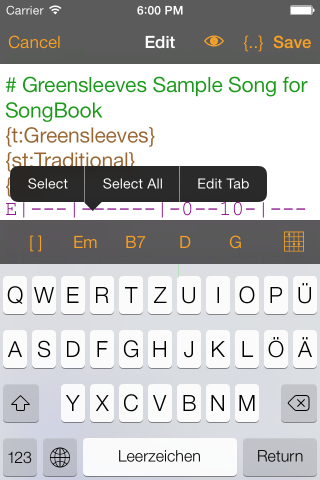
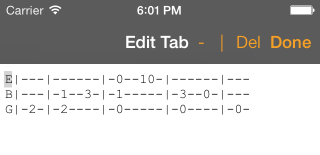 Song Editor
Song Editor
You can edit songs or add new songs. Use the pinch to zoom gesture to change the font size for editing a song. The Preview button next to the Save button will show you a preview how the song would currently be rendered without saving it. On the iPad in landscape mode, the preview will only take up half of the screen so you can edit and see your changes in realtime. On iOS 6 and above, the editor will mark the chordpro control statements in different colors (syntax highlighting).
To see more text on the iPhone, use a three-finger tap on the text view to hide the keyboard. SongBook supports the normal iOS undo methods: shake the device (iPhone) or use the Undo button on the .?123 keyboard (iPad).
The {..} menu in the upper right lets you easily enter the most common chordpro control statements. Inserting {...} controls or [] while text is selected will "wrap" the control around the selection.The first letter after the opening square bracket [ will automatically be converted to upper case.
The entry "Keyboard Chord Row in the {..} menu toggles an extra keyboard row with the chords that are currently used in the song. Chords that do not fit on the toolbar can be accessed from the menu button on the right. There you can also open the built-in chord library for lookup of arbitrary chords.
SongBook features a unique tab editor that lets you edit tablature sections (tabs) with a fixed font. You activate it by choosing Edit Tab from the context menu while inside a {sot}...{eot} section, or when inserting a new {sot}{eot} directive with the {..} button. In the tab editor you can toggle between overwrite mode and insert mode via the context menu. In overwrite mode, tapping space will just move to the next position, while tapping delete will move to the previous position. Use the buttons in the toolbar to insert a whole column of "-" or "|", or delete the current cursor column.
 Tags
Tags
To further organize your song collection, you can assign arbitrary tags to a song. On the main song category screen, you can switch from Categories to Tags to filter songs by tags. Select additional tags from tag icon in the upper right of the song list to show only songs that contain all or any of the selected tags.
When you remove a tag, the song is not deleted. However, if you delete all songs that contain a certain tag, that tag will disappear from the list of tags. Unlike with categories, songs can have several tags assigned. In the song, tags are stored with a {tag: xx} directive.
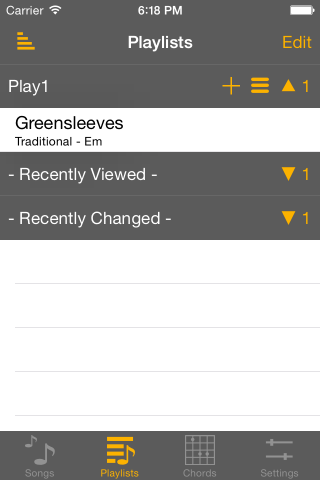 Playlists (Set Lists)
Playlists (Set Lists)
Playlists (aka sets) are collections of songs for a special purpose, e.g. a concert, or training. Playlists behave just like iTunes and iPod playlists. Removing a song from a playlist does not delete the song from either the device (it remains in its category), nor any other playlist the song might be in. Songs can be in multiple playlists, and in fact, can occur multiple times in a single playlist. You can collapse and expand playlists for easier navigation.
Use the Edit button to add, delete or empty existing playlists. The sort button in the upper left allows you to sort the list of playlists alphabetically or by date.
Use the + button to add songs to a playlist. Alternatively, you can add the currently displayed song to a playlist with the "Add To Playlist" menu from the song view.
To change the order of songs in a playlist, select Edit, then drag the song by its handle on the right hand side up and down to the new position in the playlist. You can also shuffle or sort your playlist via the action popup menu.
Use the menu button for various other functions like printing or it or sending a playlist via mail to another SongBook user.
SongBook comes with two automatic playlists that list the most recently created/changed or viewed songs, respectively. You can switch these playlists on/off in edit mode, and also adjust the number of entries.
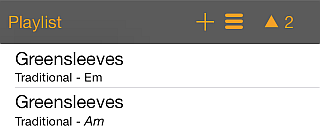 Playlists can automatically transpose songs to different keys. To store a different key for a song in a playlist, open the song from the playlist (not from the song list), then transpose it as usual, but do not save the transposed song. If a playlist song has a different key then the original, the key will be shown inverse.
Playlists can automatically transpose songs to different keys. To store a different key for a song in a playlist, open the song from the playlist (not from the song list), then transpose it as usual, but do not save the transposed song. If a playlist song has a different key then the original, the key will be shown inverse.
Note: Playlists contain only references (via title and subtitle) to the real song. If you remove the song, it is not automatically removed from the playlists but can no longer be viewed. When you change the title or subtitle of a song, all playlists that reference this songs are automatically updated.
You can add notes to playlists, e.g. "Break" or a short story to tell between songs. These notes are displayed and edited just like normal songs, but are only stored in the playlist.
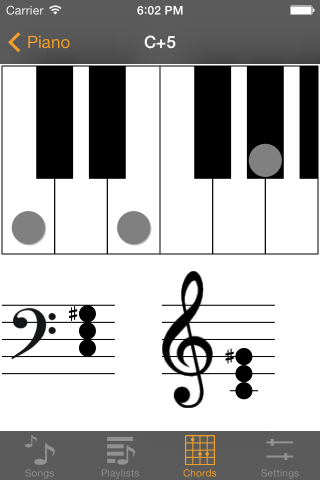
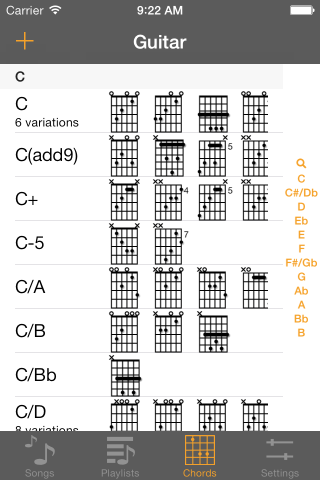 Chords and Instruments
Chords and Instruments
SongBook comes with comprehensive, extensible chord libraries for many instruments like guitar, ukulele, mandolin, banjo, and piano. You can view and change the tuning of the selected instrument in Settings.
Chords are sorted by base pitch. Each chord can have several variations. SongBook knows about identical pitches (e.g. C# = Db). Click on the looking glass to search a chord by name or by fingering (enter e.g. 2 2 1 to find Am and more chords with this fingering).
By default, SongBook displays the most simple variation (lowest base fret, least number of fingers) in the chord band. If you always prefer a certain variation, you can mark it as favorite. If you want a different variation for a certain song, you can define the chord variation in the song. If you know most chords already you can use an option in the Chords menu to show only chords defined in the song in the chord band.
To change the currently used instrument, select Settings - Instrument or tap on the chord list title. This instrument is used for all chord lookups. If you're left-handed, you can switch on left-handed chord view in Settings to see all chord diagrams with reverse string order. Select latin chords if you prefer DO RE MI formatting instead of C D E. There you can also change the standard tuning of the instrument, and the chord fingerings will be adjusted accordingly.
If a song requires a certain instrument, you can define that with {instrument: ...}. When such a song is displayed, chords will be shown for the given instrument. When you leave the song view or switch to the next song, the default instrument will be used again.
In addition, you can define a custom tuning for a song with {tuning: ...}. This also requires an instrument define in the song. E.g. you want to play a song in Guitar Drop D tuning, write
{instrument: Guita}
{tuning: D A D G B E}
User defined chords
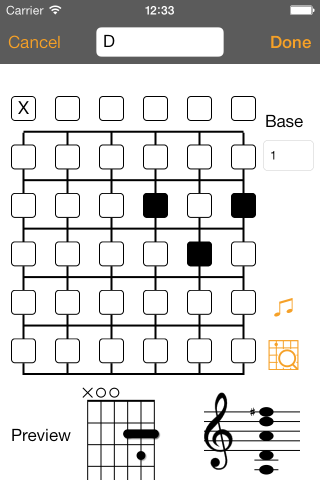 You can extend the string chord libraries with your own chords. SongBook comes with a chord editor that lets you define fingerings, base fret and muted strings. The search button on the right will look up the currently defined chord in the chord library. Tap the notes button to play the current chord.
You can extend the string chord libraries with your own chords. SongBook comes with a chord editor that lets you define fingerings, base fret and muted strings. The search button on the right will look up the currently defined chord in the chord library. Tap the notes button to play the current chord.
User defined chords will always show up in the last position in the chord view, unless you select Prefer own chords in Settings. Note: if you need a special chord only for a certain song, you'd better define the chord in the song with {define: G 0 3 2 0 0 0 3} rather than in the chord library.
Own and favorite chords are saved in a file <instrument>.chords.txt (e.g. guitar.chords.txt) in the documents folder and are synchronized with Dropbox (if linked). You can also edit this file with a standard text editor like Notepad or TextEdit. If you want your extra chords appear in the built-in SongBook chord libraries, please send us this file.
Apple Watch App
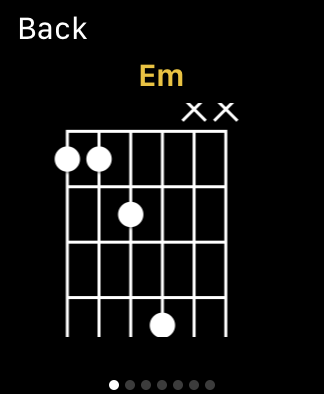
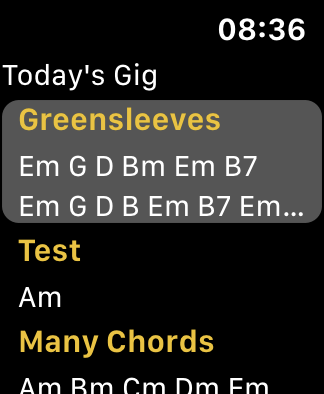 SongBook comes with an Apple Watch app for the current playlist. Select a song from a playlist on the iPhone, and you can see the current and next song on your Apple Watch. You'll see the first few chords, you can scroll through the play list and select a different song, and see chord definitions for song chords. You can select a different song from the playlist which will be shown in SongBook iPhone, and - if you use Play Together - in all connected SongBook apps.
SongBook comes with an Apple Watch app for the current playlist. Select a song from a playlist on the iPhone, and you can see the current and next song on your Apple Watch. You'll see the first few chords, you can scroll through the play list and select a different song, and see chord definitions for song chords. You can select a different song from the playlist which will be shown in SongBook iPhone, and - if you use Play Together - in all connected SongBook apps.
Feedback
Do you have a song that is not rendered correctly? Is an important chord missing in the chord database? Please let us know.
Like the app? Please rate us on the App Store.
Special thanks to Kenny Song for his invaluable help and constant encouragement.
Version History
- 5.12.2
- Song display setting to mark chords in [], e.g. to make them stand out more when Inline Chords is also active
- Change category for a playlist (useful if you share individual categories/folders with others)
- New chord band option to show only chords defined in the song (useful if you know most of the chords already)
- Reorganized chord settings, most settings are now available from the Chords menu in song view
- Requires iOS 14 or higher - 5.12.1
- fix for iOS 12 - 5.11.2
- Warn about upcoming discontinued Google Drive sync - 5.11.1
- Fix for concert mode - 5.11
- Adjust playback speed of backing tracks (also affects auto-scroll)
- Improved rendering of piano chords
- Search for chords by notes, e.g. A C E -> A
- Support multiple {midi: } lines for better structuring, will all be send together
- Support multiple {musicpath: } backing tracks, select which one to play when tapping the music icon (iOS 14 or higher) - 5.10.5
- Metronome settings now available on the metronome toolbar in the song view
- Fix for search on older iOS versions - 5.10.4
- Fixes overlapping tabbars on search on iPadOS 18 - 5.10.3
- Fixes a problem with opening links on iOS 18 - 5.10.2
- Mirror song display option (teleprompter mode)
- Drag files from other apps into song list (on iPad)
- Fix Print Playlist with Songs works now also for PDFs - 5.10.1
- fixes an issue with the display of the next song title - 5.10
- Search for categories and tags
- Allow whitespace in pseudo chords, e.g. [Verse 1]
- Improved tab conversion
- Support for user/instrument specific MIDI commands {midi-<user>: ...}
- Option to rotate view on external display (90,180,270 degrees, song menu in lower right)
- Confirmation popup if sync would delete more than 10 files in a folder/category - 5.9
- Support for time signatures like {time: 3/4} for metronome
- Edit PDFs, e.g. to mark text
- Option to show larger chord diagrams
- Fixes for Files Sync with iCloud Drive
- Czech translation thanks to Ladislav Chadraba - 5.8
- Sync with a folder from the Files app, e.g. in iCloud Drive
- Send MIDI commands with metronome tick/flash for tap tempo
- Button in Settings to delete all local files (to start over with a fresh sync)
- Print all songs of a playlist - 5.7.3
- Fix for crash on iOS 12 - 5.7.1
- Fix for Dropbox sync - 5.7
- Option to sort chords alphabetically in chord band
- Another fix for editor "jumping" - 5.6.1
- Ignore (typographical) quotes in search
- Fix editor jumping on iOS/iPadOS 16
- Long tap creates user specific quick comment if user is set in Settings)
- Fix chord diagrams in song with custom tuning
- Various smaller fixes - 5.6
- Mark chords as favorite (will be preferred in chord band)
- Option to prefer own added chords (shown first)
- Fix text color in search bars
- Keyboard shortcut Cmd-C to show/hide chord bar
- Fix editor jumping on iOS/iPadOS 16
- Fix side-by-side landscape view of PDFs in Letter format - 5.5.1
- Fixes another issue with high-contrast accessibility setting
- Some smaller fixes - 5.5
- Allow pinch to zoom in PDFs, double tap to reset
- Quickly enable Shake to scroll (accelerometer scroll) in the song menu
- Instrument-specific highlighting with {soh-Guitar}...{eoh}
- Better support for high-contrast accessibility setting
- Dropbox sync fixes - 5.4.2
- Fix for cut-off words when using highlighting with a different font/size
- Fix for pedal scrolling on iOS 12 and earlier - 5.4.1
- Fix for pedal scrolling
- User/instrument-specific inline image support with {image-user: src="file.png"} - 5.4
- Inline images with {image: src="file.png"} file.png (or jpg) must be in the same folder as the song file
- Support {duration: ...} for total playing time (compatibility with chordpro format)
- New instrument Greek Bouzouki
- Fix for OneDrive sync with a shared folder
- Fix for varying song count during sync
- Fix for a highlighting issue that could cause words at the end to disappear - 5.3.1
- Fix for Dropbox/Google Drive/MS OneDrive sync
- Fix for search - 5.3
- Can show chord diagrams in song (via chord toolbar button menu)
- Support selection of custom fonts (installed via a fonts app like iFont)
- Fix transpose in Play Together mode
- Fix support for Google Chromecast (must be enabled via song menu and needs Local Network access) - 5.2
- Support {artist: ...} (like subtitle)
- Ignore large PDFs for search indexing, switch off Searchable PDFs after a crash during indexing
- Smaller fixes - 5.1.3
- Fix for Play Together - 5.1.2
- Support user specific highlighting {soh-User}
- Ignore playlist notes in song count
- Support Google Drive shortcuts
- Various enhancements and fixes - 5.1.1
- Fixes for PDF display
- Fixes for Dropbox sync - 5.1
- Notes in playlists
- Nextcloud sync
- Set total playing time in song when linking with music
- Show PDF annotations (from iOS 11)
- Various fixes - 5.0
- Option to show all chords on chord bar (in multiple rows/columns)
- New instrument Cigar Box Guitar
- Menu to link with music file (MP3) from Files for PDFs
- Various smaller improvements/fixes - 4.9.3
- small fixes - 4.9.2
- Metronome Count-In option
- Improved midi-index functionality
- Various smaller enhancements - 4.9.1
- Song display option to show next song title
- Improved Nashville Number conversion
- Various improvements and fixes - 4.9
- Support for Jazz Grilles chord grids with {start_of_grid}/{end_of_grid}
- Long tap anywhere on a song to quickly add a comment
- Allow quick change of instrument from chords popup
- Several smaller enhancements and fixes - 4.8.2
- fix for search on older iOS versions - 4.8.1
- find text includes serchable PDFs
- new instrument Fiddle (double stops)
- various fixes and smaller improvements - 4.8
- Sync songs with Microsoft OneDrive
- Start/Stop Music button in Concert Mode
- Various fixes - 4.7.3
- Mark songs with linked music in list with note symbol ♫
- Fixes for linking songs with music - 4.7.2
- Fix for updating song after editing - 4.7.1
- Stability improvements and small enhancements - 4.7
- Several smaller improvements and fixes - 4.6.1
- Fix for Google Drive sync on iOS 9.3.5 - 4.6
- Sync with Google Drive
- Automatic chords for custom tunings
- Do not show tabs in Lyrics Only mode
- Pause for MIDI commands with PAUSE<ms>, e.g. PC03, PAUSE10, CC106.0@10
- Removed Pebble support
- Several smaller improvements - 4.5.2
- Various smaller corrections - 4.5.1
- Send arbitrary MIDI commands
- New instrument Mountain Dulcimer
- Collapse all button for playlists
- Center narrow songs can be switched off in song display settings
- Several smaller improvements and fixes - 4.5
- Narrow songs will be center horizontally
- Various improvements and corrections - 4.4.5
- Fix for editing song tags - 4.4.4
- Enhancements for tag filtering
- New instrument Ronroco
- Several smaller improvements and fixes - 4.4.3
- Several fixes - 4.4.2
- Link with music from Files app (will copy music file into SongBook directory and link via {musicpath: ...})
- Keyboard shortcuts for song display (for programmable pedals): hold cmd key to see list of shortcuts
- Fix for Edit Tab mode - 4.4.1
- fix for broken "Open-In" functionality - 4.4
- Support for Files app: Add from Files in SongBook with the + button
- Duplicate song creates a new unique title to avoid issues with playlists
- Special concert mode
- Enhanced Ukulele C chord database
- Various small improvements - 4.3.3
- More fixes for iOS 11 and iPhone X - 4.3.2
- Configurable page scroll percentage
- Chord bar in same color as lyrics
- Various smaller fixes - 4.3.1
- improved compatibility with iPhone X and iOS 11 - 4.3
- rename PDFs
- re-organized Settings
- smaller fixes - 4.2
- Option to number songs in playlists (in playlist sort menu)
- New instrument Guitalele
- Fix for chords with custom tuning - 4.1.3
- Minor improvements - 4.1.2
- Performance improvements Dropbox sync - 4.1.1
- ask to re-link with Dropbox if no longer logged in
- small fixes - 4.1
- New and improved Dropbox Sync implementation
- User/instrument specific tabs, e.g. {sot-Guitar}...{eot} or {sot-Lead}...{eot}
- New icon
- Fix for instrument-specific comments {c-Guitar:Guitar Comment}
- Several other fixes - 4.0.1
- Instrument specific directives for define so you can have one song file with different custom chords for different instruments:
{define-Guitar:...}, {define-Ukulele_C: ...}
Note: when looking up a chord, the first matching define wins, so instrument or user specific defines must come before general ones
- Improved stability for Play Together - 4.0
- Option to start linked music with auto-scrolling
- Auto-link PDFs to MP3 file with same name (e.g. Song.pdf -> Song.mp3)
- Can send arbitrary MIDI commands as hex byte string, e.g. {midi: F0 B9 00 7A B9 20 00 C9 00 F7}
- Improved import of songs from Internet search
- Requires iOS 8 or higher
(Apple no longer supports older iOS versions with their latest development tools)
- Smaller fixes - 3.9.5
- icon fix on iOS 10 - 3.9.4
- fix for crash if song contained invalid {tuning: ...} - 3.9.3
- Song-specific custom tuning with {tuning: ...}
Note: must be used in conjunction with {instrument: ...}
E.g. for Drop D Guitar tuning, write
{instrument: Guitar}
{tuning: D A D G B E}
- show category in song list if - All Songs - selected
- include key when sharing/printing playlist
- better readability for popup menus on iPad
- Smaller fixes - 3.9.2
- "Open In" SongBook now also for PDF files
- Smaller corrections - 3.9.1
- fix chord bar update in fullscreen mode - 3.9
- Show two PDF pages side-by-side in landscape mode
- Zoom to content for PDFs
- Option to left-align title/subtitle (song display settings)
- Option to mark end of song (song display settings)
- Remove Chord Move functionality due to incompatibility with iOS 9.3
- Small corrections - 3.8.1
- fix for crash when sorting a category by date which contains PDF files - 3.8
- Support for PDF files
- User-specific directives for comments, capo, instrument, so you can have one song file with different instructions for guitar/bass, or lead/background:
{comment-<user>:...}, {capo-<user>: ...}, {instrument-<user>: ...}
User specific directives will only be shown if <user> is set on the Settings tab.
- Deep linking by title/subtitle to songs with URL scheme songbook: so you can open songs in SongBook from other apps.
songbook:///show?Greensleeves
will open the sample song Greensleeves. Separate titles/subtitles with %20-%20, e.g.
songbook:///show?Greensleeves%20-%20Traditional
* Smaller fixes - 3.7.1
- fix for iOS 7 - 3.7
- MIDI support: send MIDI commands when selecting a song, select song with MIDI command, MIDI pedal scrolling
- Type-setting in right-to-left languages
- Auto-link to songs in Music (iTunes)
- Create playlist from category
- Option to switch off synchronized scroll in Play Together mode
- Improvements for import from Internet Search
- New instrument 5-string bass (Bass_5)
- Performance improvements when using auto-zoom on older iPads
- Various fixes and improvements - 3.6.1
- splitview/multitasking support (iOS 9)
- you can use spotlight to search for SongBook songs (iOS 9)
- runs on iOS 6 or later
- watchOS 2 support
- fix for font selection
- fix for Play Together when selecting songs from a playlist
- Smaller fixes - 3.6
Apple Watch integration:
- quick glance to see next song and chords
- app to scroll through current playlist with song titles and chords
- select any song from playlist. Works also with other iOS devices via Play Together feature.
- quickly look up chord definitions for selected song
Support {musicpath: file.mp3} to link to local music files in SongBook folder
Reorganized font/color settings
Stability improvements for Play Together mode
Smaller fixes - 3.5.1
- Fix for syntax highlighting in song editor
- Re-enable adding a song multiple times to a playlist (from song view)
- Several smaller fixes - 3.5
- Use playing time instead of tempo for auto-scroll (zoom/device independent, compatible to Android/Mac versions) with {time: mm:ss} directive
- Show playing time in playlists
- Improved tag filtering
- Option to go to next/previous song when scrolling with pedal
- Stability improvements for Play Together functionality (iOS 7 and later)
- Several fixes - 3.4.2
- seveal fixes - 3.4.1
- fix editor jumping on iOS 8
- fix play together issues
- Fix tapping playlist title to open/close playlists
- several smaller fixes - 3.4
- Improvements for managing playlists (sets)
- Playlists in sub folders are now included (useful when sharing a sub folder via Dropbox)
- Option to export (and import via Open-In) font settings (to have the same formatting on several iPads/iPhones, or to switch formatting)
- Settings button in song editor for syntax highlighting, auto-corrections/-suggestions, chord bar
- Several fixes - 3.3.1
- several important fixes for iOS 8
- better song sharing
- option to show lyrics only on Chromecast
- allow portrait upside down mode for iPhone
- fix: changing keys for songs in playlists could lead to duplicated, empty songs
- Minor fixes - 3.3
- Transpose: Capo setting, Convert to and from Nashville Numbering System
- Playlists: Better sharing options: as text, as file, with songs
- highlighting: custom colors with e.g. {soh #rrggbb} (hex web colors)
- neues Instrument Charango
- Minor fixes - 3.2
- Option to automatically start auto-scrolling with pedal down
- Filter for multiple tags
- Sort playlists by date
- Show key in transpose toolbar, allow changing key with popup
- Show song key in title bar
- Ask for title when creating new song
- Support for song display on Google Chromecast
- Fix: printing/PDF generation would sometimes skip a line
- Minor fixes - 3.1.1
- fix for crash on iPad 1/iOS 5 - 3.1
- Access current playlist from song view on iPad
- Slower page scrolling when using pedal or two-finger-tap
- When auto-playing, pedal scroll will only scroll two lines up/down
- Show total song playing time on auto-scroll toolbar
- Stability improvements - 3.0.4
- several workarounds in song editor on iOS 7
- option to switch off syntax highlighting in song editor (in {..} menu)
- fix for issue with saving transposed songs
- several minor fixes - 3.0.3
- Improved add/rename handling for categories and playlists
- Bug fixes in song editor
- Improvements in color contrast
- Fixes for play together
- Minor fixes - 3.0.2
- More fixes for iOS 7 - 3.0.1
- Several fixes for iOS 7 - 3.0
- New design for iOS 7
- Keys in playlists: to store a song with a different key in a playlist, just open the song from the playlist and transpose it (without saving)
- Transpose button will have different color if song is temporarily transposed
- Song-specific instruments with {instrument: xxx}
- Preserve state of chord band (on/off)
- Share songs and playlists via Open-In dialog (AirDrop, File Sharing apps, clipboard,...)
- Allow fret numbers higher than 9 for custom chords
- Auto-start scrolling with music if song contains tempo and pause directives
- Fix: custom chords were not loaded after app restart
- Minor fixes - 2.8.1
- Fix: saving songs would create duplicate entries in song list - 2.8
- Tags for songs: each song can be assigned an arbitrary number of tags, songs can be filtered by tags
- New chordpro directive {pause: xx} to pause auto-scrolling at this position for xx seconds
- User defined chords are automatically uploaded to Dropbox
- Performance improvements for initial song loading
- Fix: adding a playlist would rename first playlist
- Fix: swipe-to-delete on playlists could crash if automatic playlists were open
- Minor fixes - 2.7
- Automatic playlists can be switched on/off, number of items can be configured
- Highlight text with {soh}...{eoh}
- Option to mark chorus with bar, indentation, or shading
- Option to show lists with same color as lyrics (e.g. shaded)
- Improved printing and PDF generation
- Keep chord keyboard bar stable when adding chords in song editor
- Fix that could lead to only partially scrollable/editable playlists
- Minor fixes - 2.6.1
- Fix for crash of song editor on iOS 5 - 2.6
- Buttons "All b" and "All #" on transpose toolbar (iPad, and iPhone landscape)
- Option to inline chords (for compact song display)
- New automatic playlist to show last opened songs
- Deleted/moved songs are immediately deleted/moved on Dropbox
- Redesigned chord move mode now also on iPhone, start from edit context menu
- Re-organized song view toolbars
- Auto-refresh chords on song editor chord bar
- Option to switch off tab support (restores pre 2.5 behavior)
- Minor fixes
- Dropped support for iOS 4.3 - 2.5.1
- fix for editor
- extra setting to switch off synchronizing changed songs in "Play together" mode - 2.5
- Support for tab files (chords on separate lines above lyrics): auto-detect chords, format, transpose
- Special song edit mode for moving chords (iPad, iOS 6 only)
-"Play together" mode now also synchronizes transpose values and song updates
- Option for not switching to next/previous song when scrolling with BT pedal
-"Link iPod Song" tries to automatically look up title in iPod music library
- Updated Ukulele C chord library
- Fix for playlists that contain songs with hyphen (-) in title or subtitle
- Fix: chord search by fingering was broken in chord list
- Minor fixes - 2.4.1
- Fix for bluetooth pedal support on iOS6
- New icon
- New instrument Tenor Banjo
- Minor fixes - 2.4
- Chordpro syntax highlighting in song editor (iOS 6 only)
- Support larger iPhone 5 screen
- Transparent color in font preferences
- Dropped support for iOS 4.2 (due to Apple dev tools changes)
- Fix: recent changes appear to have been lost if you've switched back to SongBook from another app
- Fix: dropbox sync would sometimes overwrite newer version in dropbox
- Minor fixes - 2.3
- improved metronome with more regular ticks
- custom tuning
- accelerometer sensitivity setting (for page turning)
- song list can be sorted by last modification date
- duplicate playlists
- better chord bar on keyboard when editing songs
- undo support when inserting chords/chordpro controls in song
- preference option to invert song colors
- preference option to show chord band on the right vs below the song
- Fix: when saving transposed song without {key} statement, a wrong key was added
- Fix: crashes when repeatedly using action menu on song list
- Minor fixes - 2.2.1
- fix for crash when adding playlists
- fix for crash when swiping past last song - 2.2
- lefty support: show chords in reverse string order for left-handed players
- option to scroll pages with tap on device/table (accelerometer)
- show only lyrics on external display (for sing along), on song action menu
- option to show latin chord names (Do-Re-Mi)
- show wait cursor for categories that are currently synchronized with Dropbox
- if dropbox sync is set to automatically, start sync automatically when becoming active (from background or screenlock)
- search on song list now standard at top of list
- buttons to insert a column of "-" or "|" in tab editor
- when importing songs from internet search, search view will now stay after returning from edit view (for further search)
- shuffle or sort songs in playlist
- enharmonic transposition (transpose all chords to # or b, depending on key), also update {key: } control statement
- reconnect button when losing connection in "Play together" mode
- remember state of chord bar on song editor (switch on/off via [..] on long-tap context menu)
- new instruments: Bass Guitar and Irish Bouzouki
- tap on chord list title to change instrument
- high-res graphics and small fixes for new iPad
- fix: ignore special write-protected Inbox folder (existing songs in this folder are moved to Unfiled)
- fix: AirTurn didn't work when returing from background
- fix: auto-zoom didn't calculate border correctly
- fix: Open in SongBook didn't work if SongBook was already running in the background
- fix: addings songs to playlists with hyphen in title and no subtitle didn't work
- Minor fixes - 2.1
- preview for song edit (on iPad landscape side by side with edit view)
- special tab editor (via long-press context menu inside {sot}{eot}, iOS 5 only)
- pinch to zoom on song edit view
- three-finger tap on song edit to hide keyboard
- support web links in song view
- tap on chord in chord view below song to open full chord view
- if instrument is piano, show notes in chord view
- send or print song list of current category (similar to playlist)
- simplified font selection, allow only fixed width fonts for tabs
- added back support for iOS 4.2
- page scroll scrolls to whole lines
- fix: Dropbox created conflicting copies when editing a song multiple times
- fix: editing bottom of song was not possible on iOS 4.x
- fix: starting/stopping iPod songs was unreliable
- fix: handle chords in parentheses [(Am)] correctly when transposing
- Minor fixes - 2.0.1
- fix for crash when deleting songs with search order by subtitle or key - 2.0
- automatic playlist shows recently changed songs
- new Dropbox SDK. Note: you need to re-link your Dropbox account on the Settings page
- sync new/changed files immediately to Dropbox
- smoother song switching
- mark current position with fading line when scrolling whole pages (with two-finger tap or {AirTurn})
- bounce effect at start/end of song when scrolling whole pages
- save zoom/autoscroll song settings in a device family specific way (so you can have different settings for iPad, iPhone, Android, Windows)
- recognize "M" for "maj" in major chords, i.e., AM7 is actually Amaj7
- recognize (optional) chords in parentheses, e.g. (Am)
- additional/corrected chords in some of the chord databases
- show barre in chord view
- bass notes for piano instrument
- more padding on iPad
- hide statusbar in full screen mode on iPhone
- better performance when going back to song list
- fix: don't allow Edit on chord popup on iPad if instrument is piano (piano chords cannot be edited)
- fix: keyboard handling for Japanese/Chinese on-screen keyboards on iOS5
- fix: category change of songs via Edit on categories screen crashed sometimes
- Minor fixes - 1.9
- Option to play together with SongBook on other iOS devices (shows/scrolls song on the other device)
- Play chord note for note
- search fingerings in chord list, e.g. search for 0 0 2 2 1 0 to find Am
- identical chord search will ignore muted strings (i.e. X 0 0 2 3 2 is identical to 2 0 0 2 3 2)
- remember URL history in Internet search (type Other)
- two finger tap in the vertical middle of the screen will switch to previous/next song (like swipe)
- new instrument Banjo
- slider for seeking forward/backward in linked iPod song
- setting to switch off iPod style sorting (ignore A/The at beginning of title/subtitle)
- smart transpose for chords with bass notes: use same modifier (#/b) as main
- performance improvements in playlists
- Fix: chords were not visible when chosing black background/white foreground for lyrics
- Minor fixes - 1.8
- Link with iPod song (if linked, iPod play replaces metronome button in toolbar)
- Searchable chord list
- Separate color/font settings for comments
- Duplicate song (from song view action menu)
- Send song as PDF mail attachment
- Send and print playlists
- Playlists are collapsed by default
- Improved UI responsiveness while sync'ing with dropbox
- Improved tab conversion: handle leading space and empty lines between chords and lyrics
- Update user-defined chords after sync
- Fix: print song was broken
- Fix for editing chords on iPad from full screen song view
- Fix: auto-zoom on iPad showed some songs very very small
- Fix: could not add chord via chord keyboard bar at the end of a song
- Fix: chords with open strings and higher base frets not correctly displayed in song chord bar
- Fix: don't show number in song view for {columns: xx} directive
- Fix: files with uppercase file extensions were ignored (e.g Song.TXT)
- Minor fixes - 1.7
- search now also includes full plain text of song
- easier way to change category for many files: in edit categories view, use plus button to assign songs to category
- bigger combined start/stop buttons for auto-play and metronome
- help button on initial category screen
- hide/show tab bar from song list (for easier switching to playlists/chords)
- prompt user to rate app
- don't transpose non-chords in [] brackets, e.g. comments
- tab between [chords] leads to increased spacing (tab can only be entered on Mac or PC)
- fix problem with dropbox sync of categories with accented characters
- Minor fixes - 1.6
- display song in multiple columns if it fits on screen
- built-in metronome
- ignore "A ", "The " when sorting titles/subtitles (like iTunes)
- increased maximum scroll speed
- large sliders to change speed, zoom or metronome interval
- direct access to settings from song view
- update playlists when changing title/subtitle of a song
- fix: sort by subtitle crashed if song has no subtitle
- fix: prolonged auto-off didn't work reliably
- fix: auto-scroll didn't work on VGA out
- fix: crash with some file encodings
- fix: comment was not correctly inverted if lyrics where configured as e.g. white on black
- Minor fixes - 1.5
- Dropbox file synchronization, automatic or manual
- AirPrint support for printing individual songs
- Support for page up/down with a bluetooth page turner (e.g. AirTurn)
- Show keys in song list (either defined with {key: } or based on first chord)
- sort by title/subtitle/key
- Improved song import e.g. from ultimate-guitar.com
- Remember last internet search/URL
- Chord row for songs bigger on iPad, will stay on when rotating device
- Option to (not) invert song chord row
- fix: Greensleeves sample song was duplicated if empty Unfiled category
- fix: crash when connecting VGA output to some (analog?) devices
- fix: crash when searching in empty category
- fix: auto-scroll tempo was not correctly updated with tempo saved in a song
- Minor fixes - 1.4
- show chords at bottom/right of song view
- user can extend chord library with own chords
- search for chords by fingering (from edit chords view)
- chord can be defined in current song
- notes preview in chord edit view or piano chord view
- support VGA out in song and chord view
- in song edit view, access used chords and look up chords from extra keyboard bar (via [..] context menu)
- added Ukulele Bariton and Piano libraries, chord lib updates
- fix: chord list sections for identical chords (e.g. C#=Db) - 1.3
- built-in Internet search for chordpro songs (globe icon in song list)
- confirm deletion of categories
- collapsible playlists
- free font selection
- option to not show title/subtitle in song view (to save space)
- reset prefs to default
- start/stop autoscrolling with three-finger tap (unless used for other functions)
- zoom up/down buttons in zoom toolbar
- auto-upper case when entering [Chords]
- fix for editing in landscape mode
- fix for crash when adding playlists on iOS 3.2 - 1.2
- two finger tap in song view to scroll page up/down
- cancel when editing songs
- zoom: non-sticky (only for current song) when pinching,
sticky when using slider, save per song possible
- playlist editing reworked, adding songs now much easier
- fix tab conversion bugs, *.txt files are no longer converted to chordpro
- prefs option for making chords not selectable in song view
- [] context (popup) menu in song edit
- inserting chordpro controls will "wrap" selected text - 1.1
- auto-scrolling
- conversion of tab files (files that have chord names on separate lines)
- pinch to zoom, higher zoom factor in prefs
- multi-tasking (stay open in background)
- background color for text/chords/tabs, live preview
- up/down buttons for transpose
- handle duplicates when categorizing (warn/overwrite)
- color picker with transparency - 1.0
- First public version for iOS 3.2 and above
